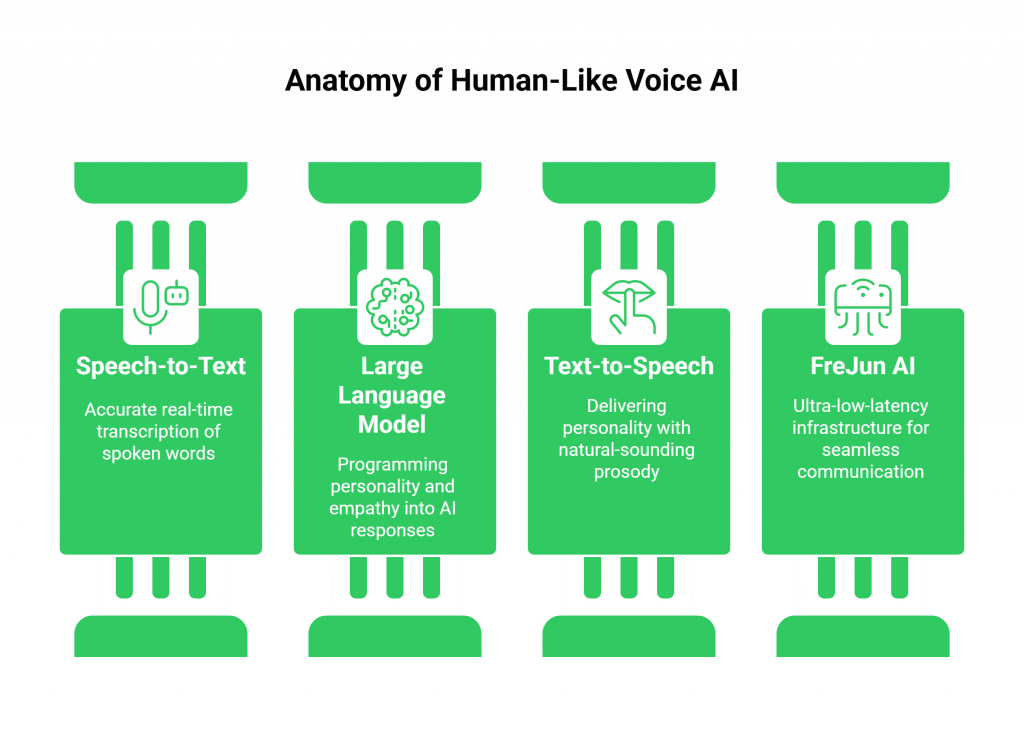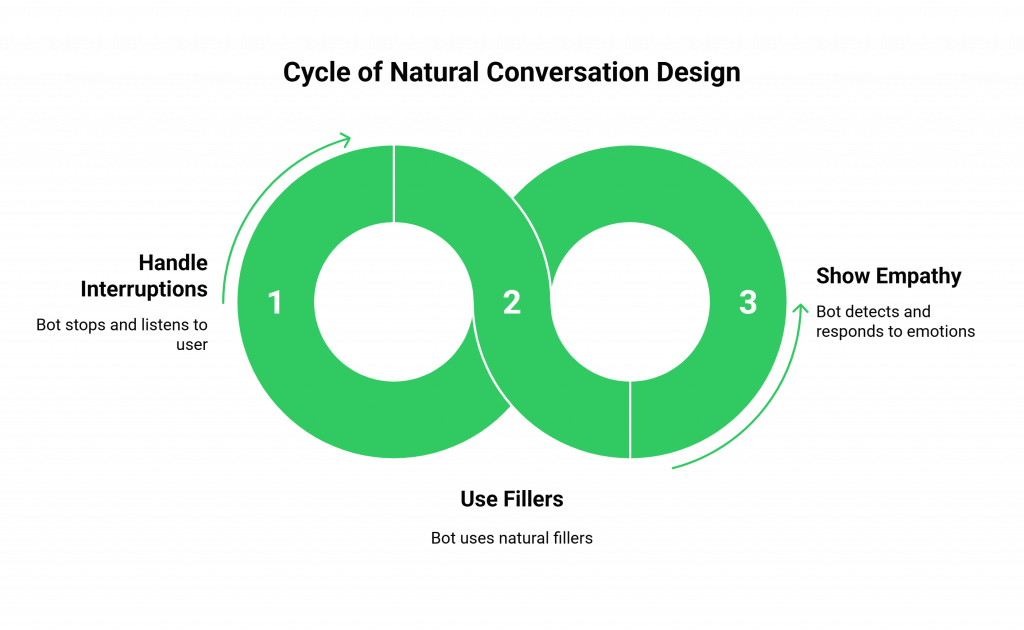We have all had that slightly unsettling conversation with a Voice Chat Bot. The voice is clear, the words are correct, but something is fundamentally off. There’s a fractional-second delay before it responds, a perfectly monotonous tone that lacks any emotion, and an inability to handle the messy, overlapping nature of a real conversation. This is the “uncanny valley” of voice AI, it’s close to human, but the small imperfections make it feel alien and frustrating.
Creating a bot that sounds human is the holy grail of conversational AI. It’s not just about fooling a user; it’s about building trust, fostering engagement, and creating an experience that is genuinely helpful and pleasant. The secret to achieving this doesn’t lie in a single piece of magical technology. It’s a delicate art, a symphony of three key elements: the rhythm of the conversation, the personality of the words, and the quality of the voice.
This guide will move beyond the basics and explore the advanced techniques and architectural choices you need to make to create a Voice Chat Bot that doesn’t just talk, but truly converses.
Table of contents
What Truly Makes a Voice Chat Bot Sound Human?
To build a human-like bot, you first have to deconstruct what makes human conversation feel natural. It’s a complex dance of timing, tone, and context. A truly human-like AI must master all three.
How Important is the Rhythm of Conversation?
This is the single most important and often overlooked element. Human conversation is a rapid, back-and-forth exchange. The tiny pauses, the quick interjections, this is the rhythm. The delay between when you stop speaking and the bot starts responding is called latency. If this latency is too high, the rhythm is broken. An awkward, one-second pause after every single thing you say is the number one giveaway that you’re talking to a machine.
How Can You Design a More Natural Personality?
Humans don’t speak like formal documents. Our speech is filled with “conversational fillers” (“umm,” “let’s see…”), varied phrasing, and empathetic responses. A bot that says the exact same phrase, like “I can help with that,” every single time feels robotic. A bot that can vary its responses, acknowledge the user’s sentiment, and use natural-sounding language feels dramatically more human.
Why Does the Quality of the Voice Matter So Much?
The final piece of the puzzle is the “instrument” itself, the Text-to-Speech (TTS) voice. An old, robotic TTS voice will ruin even the most brilliantly designed conversation. A modern, expressive TTS voice can convey emotion, add the correct intonation to a question, and use a tone that matches your brand’s personality, whether that’s cheerful and friendly or calm and reassuring.
Also Read: How To Enable Multilingual Voice Agents With Teler?
What is the Technical Blueprint for a Human-Like Voice AI?
Achieving this trifecta of rhythm, personality, and quality requires a high-performance technology stack where each component is chosen for its specific strengths. Think of it as the anatomy of a digital human.

- The “Ears” (Speech-to-Text – STT): The ability to listen accurately, especially in real-time, is the foundation. You need a streaming STT that can transcribe words as they are spoken.
- The “Brain” (Large Language Model – LLM): This is where you program the personality. Through careful prompt engineering, you can instruct your LLM to use a specific tone, vary its responses, and show empathy.
- The “Mouth” (Text-to-Speech – TTS): This is the voice of your brand. You need a high-quality, expressive TTS engine that can deliver your bot’s personality with natural-sounding prosody (the rhythm and intonation of speech).
- The “Central Nervous System” (FreJun AI): This is the most critical component for achieving a human-like rhythm. The nervous system is the voice infrastructure that carries the signals between the ears, the brain, and the mouth. A platform like FreJun AI is this essential nervous system. It’s an ultra-low-latency infrastructure engineered to transmit audio back and forth in milliseconds. A brilliant “brain” is wasted if the “nervous system” is slow.
Ready to build a voice assistant that your customers will love? Sign up FreJun AI’s developer-first voice API.
Also Read: How To Scale Voice Agents For Millions Of Calls?
How Do You Design a More Natural Conversation Flow?
Once your technology is in place, the art of conversational design begins. Here are some advanced patterns to make your Voice Chat Bot feel more human.

- Handling Interruptions: Humans interrupt each other all the time. A truly advanced Voice Chat Bot should be able to handle this. If a user starts speaking while the bot is talking, the bot should gracefully stop, listen, and then respond to what the user just said. This requires a voice infrastructure that can handle simultaneous, bidirectional audio streaming.
- Using Conversational Fillers (Sparingly): You can program your LLM to occasionally use small fillers to mimic human thought processes. A response like, “Okay, let me see… yes, I have that information for you,” can feel much more natural than an instant, robotic answer.
- Showing Empathy: A key part of being human is recognizing emotion. By integrating sentiment analysis, your bot can detect if a user is frustrated and change its approach. The desire for this is clear. A Forrester study commissioned by Invoca found that 68% of consumers are more likely to call a business if they know they can seamlessly transition from a digital channel to a human one, indicating a need for empathetic, problem-solving conversations.
How Does FreJun AI Enable This Human-Like Quality?
The most brilliant conversational design will fail if the underlying technology can’t keep up. The speed and flexibility of your voice infrastructure are what make these patterns feel real. This is where FreJun AI provides the essential foundation for building a human-like Voice Chat Bot.
Our role is to be the high-performance “nervous system” for your AI’s brain.
- Ultra-Low Latency for Natural Pacing: Our entire network is engineered for the lowest possible latency. This is what allows you to have a rapid, back-and-forth dialogue without the awkward pauses that make a bot feel robotic. A fast infrastructure is the key to a good rhythm.
- Model-Agnostic Freedom for the Perfect Voice: We are a model-agnostic platform. This is a critical advantage. It means you have the freedom to choose the absolute best, most expressive Text-to-Speech (TTS) engine on the market to be the “mouth” of your bot, rather than being locked into a default, generic voice.
- Reliable Streaming for Advanced Interactions: Our infrastructure is designed for full-duplex, real-time audio streaming. This is the technical capability that allows your bot to handle complex interactions like user interruptions, ensuring a smooth and natural conversational flow.
Also Read: How To Integrate Tool Calling Into Voice Conversations?
Conclusion
Building a Voice Chat Bot that talks like a human is the new frontier of customer experience. It’s the point where technology becomes so seamless that it feels like a natural extension of ourselves. This isn’t just about creating a clever AI; it’s about building a connection with your customers. A recent PwC survey revealed that nearly 80% of American consumers point to speed, convenience, and friendly service as the most important elements of a positive customer experience. A human-like voice bot is designed to deliver on all three.
By mastering the art of conversational design and building on a foundation of a high-performance, low-latency voice infrastructure, you can create a voice experience that is not only efficient but also empathetic, engaging, and genuinely human.
Want to learn more about the infrastructure that powers the most human-like voice assistants? Schedule a demo with FreJun AI today.
Also Read: How Automated Phone Calls Work: From IVR to AI-Powered Conversations
Frequently Asked Questions (FAQs)
The “uncanny valley” is a term used to describe the unsettling feeling a person gets when an AI or robot is very close to being human-like, but small imperfections make it feel strange or “creepy.” For a Voice Chat Bot, this is often caused by unnatural pauses or a robotic tone of voice.
It is extremely important. The Text-to-Speech (TTS) voice is the personality of your brand. A high-quality, expressive voice can build trust and rapport, while a low-quality, robotic voice can make the entire experience feel cheap and frustrating.
Latency is the delay between when a user stops speaking and the bot starts responding. For a conversation to feel natural and real-time, you should target an end-to-end latency of under one second, and ideally closer to 500 milliseconds.
This is an advanced feature that requires your voice infrastructure to support “full-duplex” communication and your application logic to be able to detect incoming audio while it is sending outgoing audio. When it detects the user speaking, it should immediately stop its own playback and switch to a “listening” state.
These are small words or phrases that humans use to signal they are thinking or processing, such as “umm,” “let’s see,” or “okay, one moment.” When used sparingly and appropriately, they can make a Voice Chat Bot sound more natural.
The LLM provider (like OpenAI or Google) provides the “brain” that decides what to say. FreJun AI provides the “nervous system” that handles the telephony and the real-time audio transport, ensuring the conversation happens with speed and clarity.
An AI doesn’t feel emotions, but it can be programmed to show empathy. By using sentiment analysis to detect a user’s frustration, it can be instructed by the LLM to use empathetic language, such as, “I’m sorry to hear you’re having trouble with that. I understand that can be frustrating.”
The best way is through blind user testing. Have real people interact with your bot without telling them it’s an AI and then gather their feedback on how natural the conversation felt. This is a form of a “Turing test” for voice.
The first step is often to upgrade your TTS voice to the highest quality, most expressive option available. The second is to review and rewrite your bot’s scripts to use more natural, conversational language.
The cost of high-quality TTS has come down dramatically. While the most advanced and expressive voices can be more expensive than standard ones, they are still a very small fraction of the overall cost of a call and often provide a massive return on investment in terms of improved customer satisfaction.
